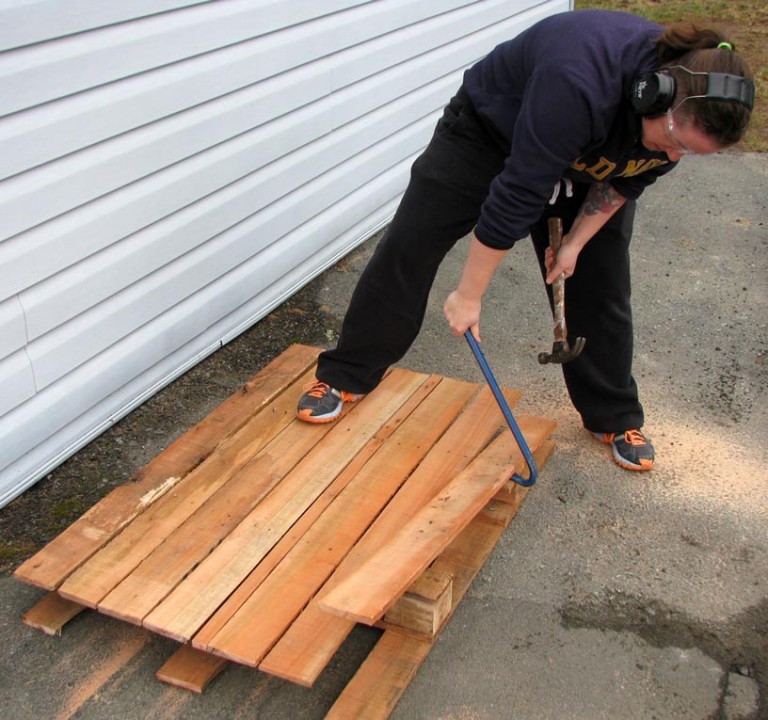Leather Strap Pallet Shelf DIY
Let me start off by saying thank you for checking out our (do it yourself) DIY Pallet Shelf article from Leathersmith Designs, where we always strive to provide the best quality leather products for our customers. Today we are going to show you how to make a Leather Belt Shelf from old belts and a pallet. Jamie had some old belts from years ago that were well loved but didn't fit and needed to be retired. After suggesting to Jamie that he throw them out and watching him almost have a stroke (he loves his job that much he can’t stand to let leather reach the garbage), I suggested maybe trying to build a shelf from recycled materials.Pallet shelf hanging by leather belts.

Materials For Pallet Shelf1. We receive around 5 or 6 pallet loads of leather each year. It just so happened that when we went to start this project we had just received one pallet. Starting this project meant making a list of materials:
- Two Belts
Tools used:
- Saw
Leather belts to be recycled for a strap shelf. Check your closet for some solid leather belts that are no longer used. However they are probably in perfect condition to be used for this DIY hanging shelf. They don't have to match exactly. We used a black and brown belt on the same shelf for this project. Salvage Boards For Pallet Shelf2. The first step was to take apart our pallet. Jamie wore eye and ear protectors when he used the circular saw. He sawed off the end piece to avoid having to pry up so many boards that were securely nailed. The balance of the boards were pried apart using a crowbar and hammer.
Finishing Wood Shelf3. Next we removed old nails (if needed) and cut our pieces to size. If you are using pallet wood, please take some time to sand off rough edges, discoloration and dirt.
Assembling Wood
|
4. After our boards are cut to size and sanded, we assembled the shelf itself. Drill pilot holes in the wood in advance to prevent the wood from splitting. We used 1" screws for ours but that was based on the thickness of the wood we used.
Attaching Leather Belts5. Now time to attach the leather belts. We decided to incorporate the buckle for appearance and in case length adjustment was required later. Normally we use snaps to attach buckles on the belts we make to allow our customers to change buckles if they so choose. But for this project we wanted to use leather rivets for strength so I used a drill press to drill out the old snaps and then replaced them with rapid rivets. You can use a pair of pincer pliers which is just as easy to remove the snaps. If the buckle is sewn on the belts you are using, that will also work well as long as the stitching is not worn at any point. A rivet setter was used to set the rapid rivet which keep the nice curve on the rivet cap.
This next step is a dealer’s choice step. You can choose to either secure the belt to the bottom of the shelf or not. Some people will attach the leather belts to the wall and rest the shelf within the loops without tacking or securing the shelf to the belts. This choice is fine and will not change the strength of the shelf but the shelf could get knocked out of place. Rather than use nails that might split the wood, we drilled pilot holes for screws. We chose to use 1" screws, two on either side, to secure our shelf to the belts. To do this you should punch a hole in the leather before you attach with screws. The leather hole punch tool we use is a round drive punch. You can also use the hole punch to make holes for more adjustment lengths regarding the buckle. Secure Hanging Shelf To Wall6. The final step is to hang your shelf on the wall. Make sure if you are not securing your shelf to studs in the wall, use drywall anchors. Put a level on the shelf and mark your holes that way. One belt could be stretched slightly so this way you know the shelf itself is level. Although leather is strong it can stretch slightly over time. These shelves are meant more for decoration than something like a long heavily loaded bookshelf.
DIY Shelves Finished7. Then you are Done!! These artistic hanging shelves can be used for displaying decorations, pictures, tools, canned goods or flowers.
|


























